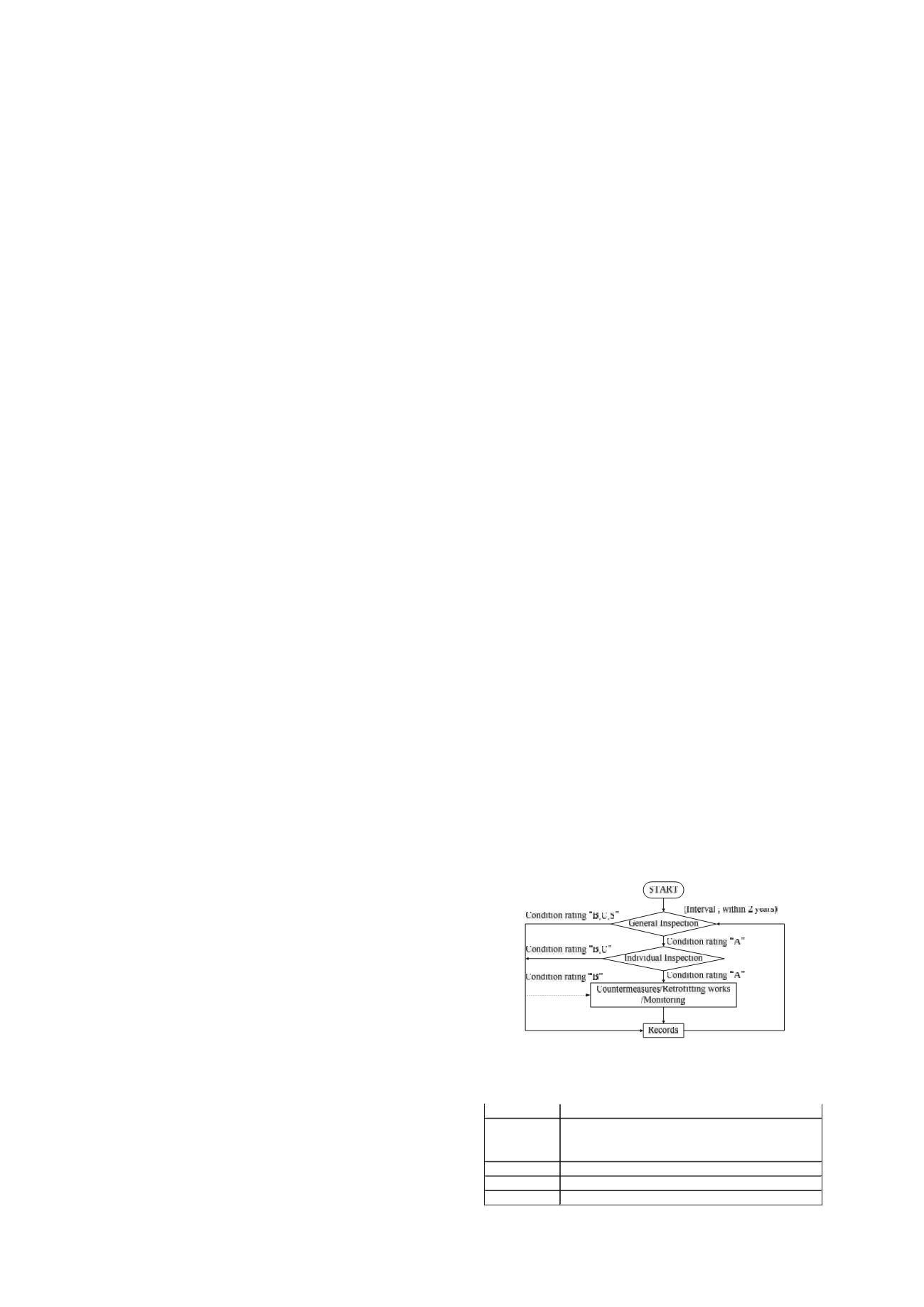
2059
Proceedings of the 18
th
International Conference on Soil Mechanics and Geotechnical Engineering, Paris 2013
1
Inspection of structural health of existing railway retaining walls
Inspection de l’état structurel des murs de soutènement des voies de chemin de fer existantes
S. Nakajima, M. Shinoda & K. Abe
Railway Technical Research Institute, Japan
ABSTRACT: This study aims to develop an inspection method of a structural health of the existing retaining walls. This paper begins
with the brief introduction of the current state of the existing retaining structures. Second, applicability of the percussion test for the
evaluation of structural health of existing retaining wall is examined by conducting a large numbers of the percussion test on retaining
walls at the site. It was found from the percussion test that structural health of the ashlars wall could be quantitatively evaluated by the
percussion test while it was found to be difficult to apply the percussion test for the quantitative evaluation of the leaning type
retaining wall. Third, applicability of the small scale vibrator, which was newly developed to improve the disadvantage of the
percussion test as the inspection method of the retaining wall, was examined thorough the prototype scale model test on the existing
leaning type retaining wall. It was found from the series of model test that the vibration tests were effective in evaluating the
characteristics of dynamic properties of the retaining walls, which were affected by structural health of the retaining walls. This result
indicated that the small scale vibration tests could be applicable to evaluate the structural health of the existing retaining structures.
RÉSUMÉ
: Cette étude vise au développement d’une méthode d’inspection de l’état structurel des murs de soutènement exi
stants.
L’article commence par une brève présentation de l’état actuel des structures de soutènement existantes. Il se poursuit par l’exposition
de l’analyse de l’applicabilité des essais aux chocs à l’évaluation de l’état structurel des murs de soutènemen
t existants conduits sur
des murs de soutènement sur le terrain. Ces essais aux chocs ont montré qu’ils permettaient une évaluation quantitative des m
urs de
soutènement de type en béton mais qu’ils ne se prêtaient guère à l’évaluation des murs de soutèneme
nt de type incliné. Une troisième
partie est consacrée à l’applicabilité d’un vibrateur à faible échelle nouvellement mis au point qui permet de palier les inc
onvénients
des essais aux chocs comme méthode d’inspection des murs de soutènement. Un appareil prototype a été utilisé pour l’inspection des
murs de soutènement de type incliné. La série d’essais modèles conduite a mis en évidence que les essais aux vibrations perme
ttaient
de bien évaluer les caractéristiques des propriétés dynamiques des murs de soutènement affectés par leur état structurel. Les auteurs
concluent que les essais aux vibrations à petite échelle peuvent être appliqués dans l’évaluation de l’état structurel des mu
rs de
soutènement existants.
KEYWORDS: Retaining walls, condition rating, small scale exciter, vibration testing
1 BACKGROUND
In Japan, there are many old existing railway structures and it
enhances the importance of the proper maintenance
methodology. For the proper management of the railway
structures, it is important to detect deformations of the
structures in early stage. Once deformations are observed,
continuous observations and retrofitting works are also
important. As for the Japanese railway structures, it has already
developed to evaluate a structural health of bridge piers
quantitatively, which makes it possible to maintain structures
efficiently. On the other hand, a visual inspection is still con-
ducted to evaluate a structural health of the existing retaining
walls because quantitative inspection method for the existing
retaining wall has not yet developed. It is required to evaluate a
structural health of the existing retaining walls quantitatively
because a result of the visual inspection is highly dependent on
the subjective judgment of an inspector.
Based on the background above, this study aims to develop
an inspection method for the condition rating of the existing
retaining walls.
2 CURRENT STATE OF THE RAILWAY RETAINING
STRUCTURE
2.1
Maintenance standards in Japan
There are approximately 30 thousand kilometers of the railway
lines in Japan, which are operated by many railway
organizations (seven Japan Railway companies, over 100
private railway companies and several local governments).
Japanese railway organi-zations maintain their structures safety
conditions by referring to the Japanese maintenance code of
Maintenance Standards in Japan (RTRI, 2007). General
procedure for structural maintenance in the Management
standards and relationships between the soundness and the
structure state are shown in Figure 1 and Table 1.
As indic
ated in Figure 1, “General Inspection” is conducted
to all of the railway structures within the intervals of two years
mainly by visual inspection. On the other hand, “Individual
Figure 1. Maintenance procedure according to the Maintenance
standards in Japan
Table 1. Relationships between rated condition and structure state
Condition rating
Structure state
A
State that threatens operational safety, safety of passengers,
public safety, gurantee of regular train operation, or
deterioration that might cause this state
B Deterioration that might result in a future soundness rank of A
C Slight deterioration
S
Good condition
Inspection of structural health of existing railway retaining walls
Inspection de l’état structurel des murs de soutènement des voies de chemin de fer
existantes
Nak jima S., Shinoda M., Abe K.


